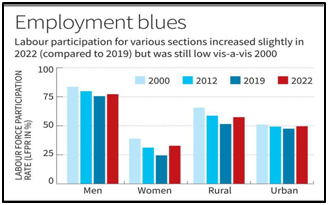Why in News?
The International Labour Organisation (ILO) and the Institute of Human Development (IHD) have jointly published a report titled “India Employment Report 2024”.
What’s in Today’s Article?
- About ILO (Background, Objectives, etc.)
- About IHD (Background, Objectives, etc.)
- India Employment Report (Key Highlights of the 2024 edition)
About International Labour Organisation:
- The ILO was created in 1919, as part of the Treaty of Versailles that ended World War I, to reflect the belief that universal and lasting peace can be accomplished only if it is based on social justice.
- In 1946, the ILO became a specialized agency of the United Nations.
- The ILO is devoted to promoting social justice and internationally recognized human and labour rights, pursuing its founding mission that labour peace is essential to prosperity.
- Headquarters: Geneva, Switzerland
Objectives of ILO:
- The ILO has four strategic objectives:
- Promote and realize standards and fundamental principles and rights at work,
- Create greater opportunities for women and men to decent employment and income,
- Enhance the coverage and effectiveness of social protection for all, and
- Strengthen tripartism and social dialogue.
Membership of ILO:
- The ILO has 187 state members.
- India is a founding member of the ILO and it has been a permanent member of the ILO Governing Body since 1922.
- The ILO constitution permits any member of the UN to become a member of the ILO.
- To gain membership, a nation must inform the director-general that it accepts all the obligations of the ILO constitution.
About Institute of Human Development (IHD):
- The Institute for Human Development (IHD) was established in the year 1998 under the aegis of the Indian Society of Labour Economics (ISLE).
- It aims to contribute towards building a society that fosters and values an inclusive social, economic and political system that is free from poverty and deprivations.
- It undertakes research in the areas of labour and employment, livelihood, gender, health, education and other aspects of human development.
About India Employment Report 2024:
- The India Employment Report 2024 is the third in the series of regular publications by the Institute for Human Development on labour and employment issues.
- It is undertaken in partnership with the International Labour Organization (ILO).
- The report examines the challenge of youth employment in the context of the emerging economic, labour market, educational and skills scenarios in India and the changes witnessed over the past two decades
- The report highlights recent trends in the Indian labour market, which indicate improvements in some outcomes along with persisting and new challenges, including those generated by the COVID-19 pandemic.
Key Highlights of the India Employment Report 2024:
- The report is primarily based on analysis of data from the National Sample Surveys and the Periodic Labour Force Surveys between 2000 and 2022.
- Employment Trends & Current Scenario:

- The female labour market participation rate, after declining significantly in the earlier years, took to a faster upward trend as of 2019, particularly in rural areas.
- One of the most significant features of the Indian labour market is a slow and steady transition of the workforce away from agriculture and into the non-farm sectors.
- Employment in India is predominantly self-employment and casual employment.
- Nearly 82 per cent of the workforce engages in the informal sector, and nearly 90 per cent is informally employed.
- While wages of casual labourers maintained a modest upward trend during 2012–22, real wages of regular workers either remained stagnant or declined.
- The migration levels in India are not adequately captured through official surveys.
- The rates of urbanization and migration are expected to considerably increase in the future.
- India is expected to have a migration rate of around 40 per cent in 2030 and will have an urban population of around 607 million.
- Challenges of Youth Employment:
- A large proportion of the population is of working age, and India is expected to be in the potential demographic dividend zone for at least another decade.
- But the country is at an inflexion point because the youth population, at 27 per cent of the total population in 2021, is expected to decline to 23 per cent by 2036.
- Each year, around 7–8 million youths are added to the labour force whose productive utilization could lead to India reaping a demographic dividend.
- Youth participation in the labour market has been much lower than among adults and was on a long-term (2000–19) declining trend, primarily due to greater participation in education.
- Youth unemployment increased nearly threefold, from 5.7 per cent in 2000 to 17.5 per cent in 2019 but declined to 12.1 per cent in 2022.
- After the lockdowns, the youth labour market indicators recovered quite quickly.
- But this movement was accompanied by additions to the labour force and workforce, primarily in poor-quality work.
- Suggestions:
- The report highlights five key policy areas for further action, which apply more generally and also specifically for youth in India:
- promoting job creation;
- improving employment quality;
- addressing labour market inequalities;
- strengthening skills and active labour market policies; and
- bridging the knowledge deficits on labour market patterns and youth employment.










